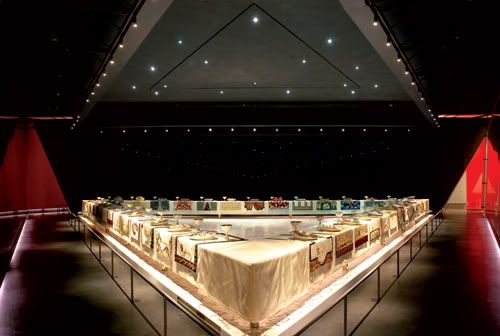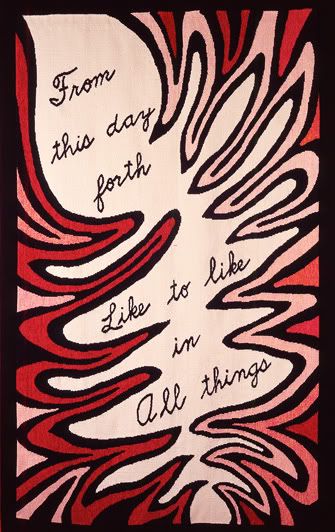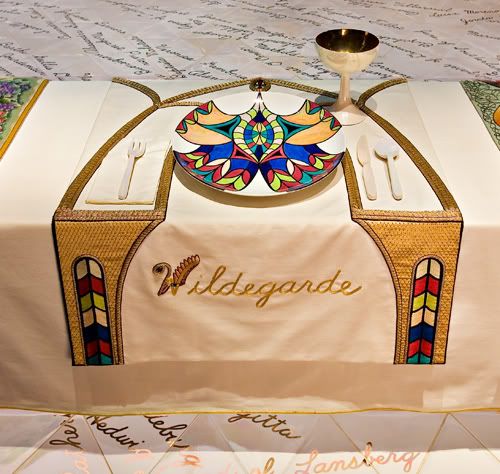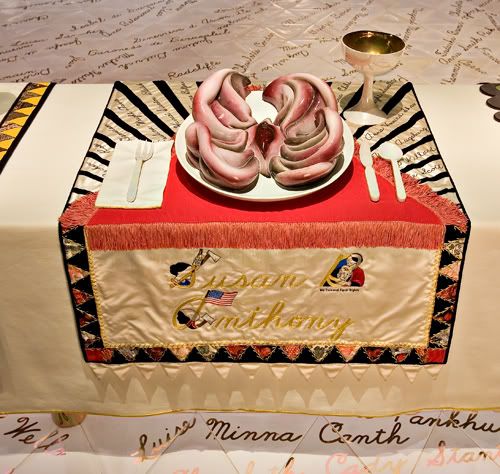This last weekend, during my mini-vacation in New York City, I decided that I needed to put my money where my mouth is and do something special for Women's History Month. Instead of my planned visit to The Cloisters (I'm a medieval historian...the cloisters are like Mecca) I trecked all the way down to the Brooklyn Art Museum to see a work there that I have long admired.

The Dinner Party by Judy Chicago is an iconic piece of feminist art. The work recognizes (invites to the table) women who have been overlooked, misinterpreted, or undervalued by popular history. 39 women (both mythical and historical) are represented at the table, and the names of 999 others on the floor (names can be found here). It is impossible to understand how powerful this piece is, without seeing it in person. Before going, I had studied the pictures, I had read reviews and explainations, and I thought I understood. I didn't though, and you can't until you're there.
As I walked around the table, reading the names, I felt an odd sort of interaction with it. I felt like I was a server, or maybe an intern who had helped to set the whole thing up...both part of the dinner and yet still seperate. I experienced a little thrill of excitement and pride every time I recognized the name of a woman that I admired who had been given a place of honor. I felt both curiosity and shame everytime I encountered a name that I didn't know. So special a woman, and I didn't know her? That wasn't right! I could have stayed there for hours, starstruck.
Now, I'm sure many of you are thinking to yourself, "this is all well and good, but what the heck does this have to do with textiles." Well now, I'm glad you asked, because this is what makes The Dinner Party so absolutely amazing (at least in my opinion). As a large scale installation, there is no single medium or technique used. Instead, the work is comprised of many materials and methods. Many of the methods used, however, are what are regarded as traditionally feminine arts.
The entrance banners (one of which you see here) are woven.

Each place setting contains a painted china plate and a runner, personalized to fit each woman and her period. The embroidery used in Hildegarde of Bingen's runner, for example, was common in ecclesiastical garments of the medieval period.

Susan B. Anthony's runner contains elements of friendship or memory quilts that were popular at the end of the nineteenth century. Emboidered in the white rays are names of other prominant sufferagists.

The website (which I linked to about a kagillion times) is fabulous. I really encourage you to take a look and enjoy both the beautiful art contained in these textiles and the rich history that they honor. Judy Chicago understood and honored that fact the women's history and textiles are intertwined. Much can be expressed through them, both in the past and still today.
BN: All images are from the Brooklyn Museum webpage. The original context is accessable by clicking the image.









1 comment:
Hey! I found your blog through Whip it Up. I'm a Smith '00 grad and our Commencement speaker was Judy Chicago. It was the worst speech I've ever heard given at a commencement. She basically said that you can't have both a family and a career! It's a true shame that someone who created such a powerful and evocative piece of art should be so soured to the ideals of so many women.
Post a Comment